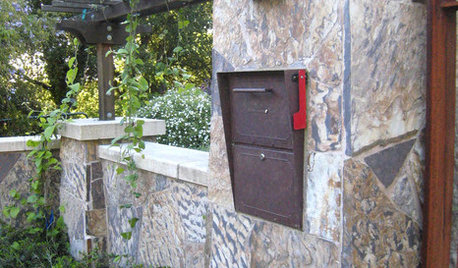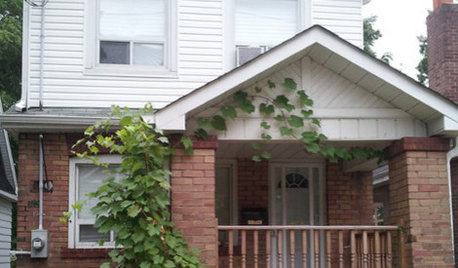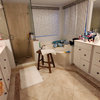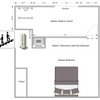Keep exterior wall pipes from freezing... help!!
sofibebe
8 years ago
last modified: 8 years ago
Featured Answer
Sort by:Oldest
Comments (8)
greg_2015
8 years agosofibebe
8 years agoRelated Discussions
Keeping my citrus from freezing in the greenhouse
Comments (3)Looking good there! I have been so sick but not to sick to take a peek and say Bravo! I love the looks of that greenhouse. Great job. I also like the idea someone gave about using plastic to make a barrier! By the way, I found that a ceramic heater cost's a lot less than the one you are using:-) Even one of those infared heaters now being sold would cost you less money on the electric bill and you can set it to go off at certain temps. Thank God those frigid temps are gone for a while, right!? Mike...See MoreInsulating existing walls & freezing pipes
Comments (8)This is a project my dad I did the latter part of last winter. I had already gutted the kichen, it wasn't salvagable, and discovered pipes not really in the wall, but between the old plaster and drywall that a PO did (plumber said definately a diy project and done incorrectly). Before any plumbing was rerouted to not be in the wall, is when my dad and I blew in insulation. You could tell the 1 corner in the kitchen had insulation, but that was it. We were fairly confident there was no other insulation except some in the attic. We blew in cellulose. We did it from the inside by measuring over from a corner about 8". He then used a 1" hole bit. This is where my dad got creative :) He had me find an old wire hanger and he first straightened it out and then made a bend in it. He put it in the hole he had drilled out and went over to where he found the stud. Then he measured how far over to get more accurate for the next hole, measuring to try to be 16" apart. He made holes all around in each room on the outside walls and below windows. At Menard's, when you buy cellulose, you're given a days free rent of the blower. We spent one day drilling holes and the next day filling them. We started on the first floor...only to discover that we have a balloon structure and some of the cellulose came out underneath the baseboards upstairs (the quarter round had been removed long before us). We could have just made the holes upstairs, but live and learn. We did the upstairs the next week, using a blower the carpenter I'd hired had. The kitchen and 1/2 bath were different since I'd gutted them. In those 2 rooms, I used the roll insulation. Both were sooo easy to do and who knows how much it saved us by not hiring the job done. I can also say that the heating bill was virtually cut in half after blowing in the insulation. The holes were easy to fill with plaster when we were done, either the carpenter or myself did those. Tony's way was easier than mine. He already had plaster made up for another room he was working on and took a bag, filled it, cut a small hole in the bottom and squeezed out the plaster into the hole. Then it was up to me to sand them down (they tended to expand out). I was just using a putty knife and trying to get it in the hole. If you're not sure where the water pipe is, (is it between the interior and exterior towards the back, or more towards the inside) I'm not sure this would work for your pipe because of the reasons stated above. But it sure would work for the rest of the house!...See MoreHelp! Furnace broken...how to keep the pipes from freezing?
Comments (14)I totally disagree about having to drain the pipes. Open all the sink cabinet doors and use space heaters. Find out if the weather is going to be clear as well as cold. If the sun is shining, your home will gain heat during the day through the windows. You also already have a warm thermal mass if the house was warm when the furnace quit and you have a basement. Your basement may not feel warm to you, but it is a far distance from freezing. It will help keep the pipes from freezing during these four days. If the weather is going to be cloudy or windy, the single digits are going to last well into the daytime, or the pipes are close to walls that are not well-insulated, then provide space heating nearby or get heat wrap for the pipes. You could also go to Lowe's or HD and get the foam insulation tubes that are split and fit right over the pipes. Unless your furnace was a hot water system that also provided your hot water, you also have the heat of the water heater to keep at east the hot lines and the fixtures and drains warm. We all should probably insulate those hot pipes, anyhow. Kerosene heaters give me the willies, I hear too much about people being asphyxiated by not venting them properly. I think electric is safer. Either way, someone has to stay home if you are running space heaters....See MoreINSULATING PIPES IN EXISTING EXTERIOR WALL- HELP!!!
Comments (7)What is the exterior siding? My first inclination is to remove the batt and use the cellulose insulation. If you can remove the siding and reapply, you could add a external WRB onto the outside of the property. I would be surprised that there is no vapor barrier on the outside of the wall. There should also be a water/vapor barrier from the tile to the insulation or interior cavity. You may want to try this question on the remodeling forum. Good luck!...See MoreUser
8 years agoWindows on Washington Ltd
8 years agosofibebe
8 years agobry911
8 years agolast modified: 8 years ago
Related Stories

GREEN BUILDINGThe Big Freeze: Inventors Break New Ground to Keep Things Cool
Old-fashioned fridges can be energy guzzlers, but there are more eco-friendly ways of keeping food fresh, as these global innovations show
Full Story
COLORPaint-Picking Help and Secrets From a Color Expert
Advice for wall and trim colors, what to always do before committing and the one paint feature you should completely ignore
Full Story
HEALTHY HOMEHow to Keep Water Vapor From Ruining Your House and Your Health
We help you find out when it’s happening, what it means and how to fix it
Full Story
LANDSCAPE DESIGNGarden Walls: Dry-Stacked Stone Walls Keep Their Place in the Garden
See an ancient building technique that’s held stone walls together without mortar for centuries
Full Story
REMODELING GUIDESWisdom to Help Your Relationship Survive a Remodel
Spend less time patching up partnerships and more time spackling and sanding with this insight from a Houzz remodeling survey
Full Story
EXTERIORSHelp! What Color Should I Paint My House Exterior?
Real homeowners get real help in choosing paint palettes. Bonus: 3 tips for everyone on picking exterior colors
Full Story
EXTERIORSSpecial Delivery: Keeping Your Packages Safe
Online sales are up, and so is the number of boxes delivered to homes. Here’s how to keep them beyond the grasp of porch pirates
Full Story
CURB APPEAL7 Questions to Help You Pick the Right Front-Yard Fence
Get over the hurdle of choosing a fence design by considering your needs, your home’s architecture and more
Full Story
ENTRYWAYSHelp! What Color Should I Paint My Front Door?
We come to the rescue of three Houzzers, offering color palette options for the front door, trim and siding
Full Story
UNIVERSAL DESIGNMy Houzz: Universal Design Helps an 8-Year-Old Feel at Home
An innovative sensory room, wide doors and hallways, and other thoughtful design moves make this Canadian home work for the whole family
Full Story








Vith